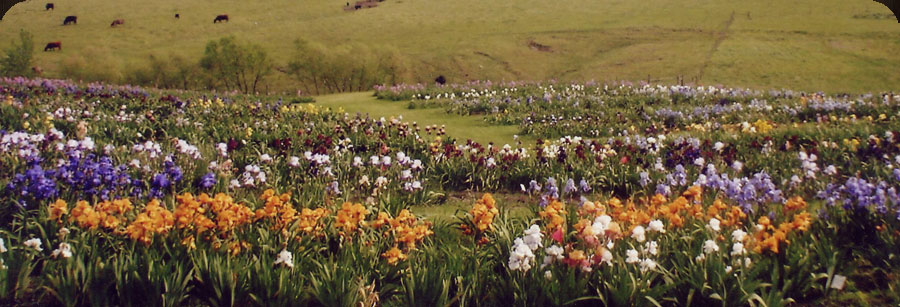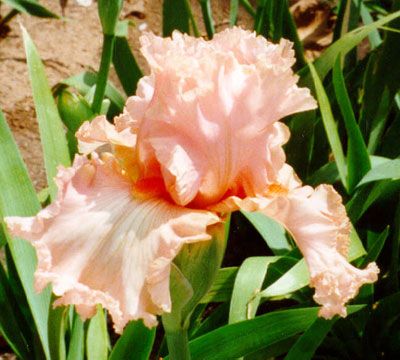
Growing Bearded Iris TYPES OF BEARDED IRISTALL BEARDED [TB] - over 27.5" bloom stalks, late bloom season THE HOW TO's ....WHEN TO PLANT - The best time to plant iris is late summer through early fall. We recommend planting from mid-July until mid-October depending on your location. Those in southern climates can usually push the deadlines and plant into November. Spring planting is discouraged but can be done under abnormal circumstances. Spring planting can often result in lack of bloom for a season or two and slow establishment. WHERE TO PLANT - For best growth and bloom, iris need at least half a day of full sun. We've had success with plants receiving morning sun until 2:00 pm, then afternoon high shade. On the farm our irises receive 100% sun. Older, historic cultivars have been observed to tolerate more shade than some of the newer cultivars. SOIL CONDITIONS - Bearded iris need a balanced, well-drained soil but are very adaptable to a variety of soil types. Raised beds can help with drainage and are a MUST for areas with high rainfall. Iris, like most perennials, prefer neutral to slightly acidic soil (pH of 6.8 - 7.0 is ideal). Heavy clays need to be amended with gypsum or coarse sand to aid drainage. In our production fields, we till the soil to a depth of 10-12" and add a dash of superphosphate or bone meal. Iris can be mulched lightly (for winter protection and weed control) as long as the mulch does not cover the rhizome. Once winter is over, it is wise to remove the mulch. HOW TO PLANT - The most common mistake made with bearded iris is planting too deep. First make a 3" deep depression about 6" in diameter. In the center make a small, fist-sized mound of soil. The rhizome is placed on top of the mound so that 1/3 of the rhizome will be above the soil. Spread the roots out to support the plant, replace the soil, firmly pack around the roots to remove air pockets and water liberally. DO NOT plant bearded iris in a low area; they will not tolerate standing water. We suggest 14-18" as a good distance between rhizomes. This allows the new growth to fill the area between plants in about three to four years. For mass or clump style plantings, plant rhizomes in a triangular fashion about 6” apart. Planting in this way will require division more often than other methods. In areas of intense summer heat irises can be planted deeper (no more than 1” below the soils surface) to avoid scalding. This rule also applies to areas with light soils. FERTILIZATION - Modern iris varieties may need more fertilizer than older varieties due to the increased number and size of blossoms. We fertilize in mid to late April with bone meal, superphosphate, or a fertilizer low in nitrogen such as 6-10-10. Fertilizers high in nitrogen tend to cause bacterial rot and lush, but weak, foliage growth. When selecting fertilizers for irises, be sure that the 2nd and 3rd numbers are bigger than the 1st. These numbers stand for the amounts of phosphorus and potassium in the mixture. Phosphorus and potassium are the key nutrients in root and bloom production. Another dose of fertilizer at half strength after fall dividing and planting will slow release throughout the winter and early spring. Though fertilizing can only help, it is certainly not necessary for growing a garden of beautiful irises. GENERAL CARE - Over time iris clumps will become crowded and bloom will suffer. In late summer simply lift the entire clump with a garden fork. Cut apart the new, younger "babies" from the older center rhizome, and replant as before. The center rhizome, although the largest, will not bloom a second time, so send it to the compost pile. Sometimes you will see new buds coming off the center rhizome. In that case you can replant as before. Irises do not like competition from weeds. Keep your beds neat and clean to allow the sun and air to keep the rhizome dry and happy. REMEMBER - iris are VERY drought tolerant! Watering is only necessary under the most severe droughts - avoid the watering can otherwise. Finally, enjoy your iris. They will produce dramatic, beautiful blooms with minimal care and outstanding blooms with just a little more. HYBRIDIZING - Many feel hybridizing is only for the experts. This is simply not true. It is a relatively simple process, but it does take up to three years to see the resulting bloom from your new creation. If you would like to try it, I'll give a very short primer here. Inside each bloom are both male and female sex organs. Just behind the beard you will see the male stamen. Directly above the stamen is the style crest. After the bloom is opened, and on a dry, windless day, take tweezers and remove the stamen. Try to keep the pollen on the stamen intact. Next rub the stamen on the lip of the style crest of another iris (there is a small sticky area that receives the pollen). It is advised to apply pollen to all three of the “sticky areas” of the receiving flower. If conditions are right (pollen receptiveness, fertility, weather, etc.) fertilization will occur. YOU MUST LET THE BLOOM REMAIN ON THE STALK. After a week or so you will see some swelling begin just below the fading bloom that you fertilized. This swelling will continue until the bloom has dropped off leaving a thumb-sized seed pod. Be sure and let the pod ripen until late summer. Keep an eye on the pod. Once it appears to be browning or splitting open harvest the seeds from inside. Let the seeds dry and plant in seed trays or in the soil in organized rows. Allow the pots to overwinter outdoors and be sure to pile snow on them or water them periodically so as to “leach” away the chemical inhibitors found in the seed. These chemicals if not properly leached will prevent the seed from germinating. To keep your crosses straight I tag the stalk with the names of the crosses. The pod parent is listed first, the pollen parent second like in this example: Gold Galore X Harvest King. In the spring the iris seeds will germinate, looking much like thick blades of grass. After seedlings are three to four inches in height, transplant them to a suitable place where they can grow into mature plants (larger pot or garden space). You will probably have to wait until the second year to get a bloom. But don't be surprised if the blooms are many different colors. Like children, the blooms may be somewhat similar, but they can surprise you. If you have questions about hybridizing or would like more information please do not hesitate to contact Kelly, the farm’s resident plant breeder. THE DYKES MEDALThe Dykes Medal is awarded annually to the finest iris of any class. Tall bearded iris have won the Dykes Medal more often than any other class. To be eligible for the Dykes, an iris must first earn the Honorable Mention (HM) and the Award of Merit (AM). The HM and AM must be separated by a two year interval. An iris must then win the medal for the class (Wister for TBs, Sass for IBs etc. before being considered for the Dykes. Learn More... |
|


